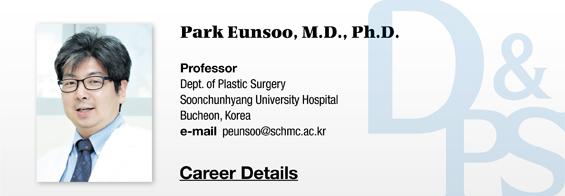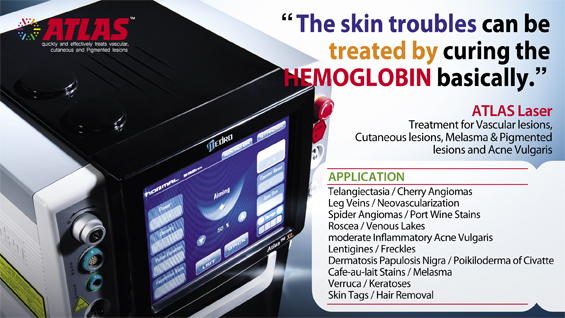▶ Previous Artlcle : #10-1. Platelet Rich Fibrin and Platelet Poor Plasma
By using autologous plasma, the PRFM filler does not induce immunological hypersensitivity reaction, allows skin tissue growth and regeneration, and is available at an affordable price. However, the effect does not last very long and there is lack of data on its clinical efficacy. In the end of August 2012, a news under the title of “Women drawing their own blood for plastic surgery: breasts might be resected rather than augmented’ was aired on JTBC News in South Korea. The news said:
[Advertisement] ATLAS(Long pulse 532nm & 940nm dual wavelength) – Manufacturer: MEDRO(www.medro.net)
A college girl learned about breast augmentation without surgery and visited a clinic in Gangnam, Seoul. She was informed from the clinic that her breasts could be augmented without side effects merely by injecting proteins extracted from her own blood. After 10 sessions of autologous filler injections, however, she only suffered breast pain without any noticeable effects. When she visited the clinic again, she found out that the fillers were tangled with mammary glands, muscles and blood vessels and the breast tissue should be partially resected. Using these cases as examples, the media have reminded people of the lack of evidence on the safety and efficacy of autologous blood fillers and warned of the possibility of cystoma, infection, tissue necrosis and other complications from injecting a large amount of fillers into breasts.
Autologous blood filler itself may be relatively safe, but the efficacy is still controversial. As with existing fillers, autologous blood fillers should not be used clinically without anatomical knowledge and sufficient considerations on the risk of complications, including vascular damage, intravascular injection, infection and tissue necrosis.
Clinical application of platelet rich fibrin
Platelet rich fibrin (PRF) is recently gaining a lot of attention for clinical use. Unlike PRP, which is obtained by double centrifugation with an anticoagulant, PRF can be easily obtained by a single centrifugation without adding an anticoagulant.
PRF concentrate naturally forms a very strong fibrin matrix. This fibrin matrix contains almost every platelet and WBC present in the collected blood. In addition, the fibrin matrix in PRF has a complex structure and maintains the stability with its strong physical and mechanical properties that are not observed in other platelet concentrates. For this reason, it is beneficial for ease of handling in clinical settings.
Each PRF slowly releases a large amount of growth factors (PDGF, TGF, IGF, VEGF, etc.) and other glycoprotein substrates (thrombospondin) over the course of about 7 days. Unlike PRP, PRF can be prepared from blood only, without the need of any artificial additives, such as anticoagulants or bovine thrombin. PRF is also free from the risk of cross infection and provides longer-lasting effects.
PRF was first introduced in dentistry in 2006 by Choukroun et al. in France. To obtain PRF, venous blood should be centrifuged for 10 minutes at 3000 rpm. For more concentrated fibrins, centrifuges designed exclusively for the purpose are recommended. Since coagulants are not used in the process, the centrifugation should be performed within a few minutes after blood collection to achieve a better result.
Centrifuged blood is divided into three layers of plasmas in the tube. The bottom layer mostly contains red corpuscules such as heavy RBCs, the middle layer contains PRF in which platelets with growth factors required for tissue regeneration are concentrated, and the top layer contains acellular plasma. The middle layer is cut with scissors to be used alone or in combination with bone graft materials. When applied on chronic wounds, various growth factors in the PRF accelerate soft tissue healing and induce bone tissue regeneration.
The characteristics of PRF, or a so-called second generation PRP, can be summarized as follows:
First, various growth factors are confined in fibrin polymer, limiting their exposure to external environments and resultant changes.
Second, the growth factors are released slowly and continuously, compared to PRP which releases growth factors explosively in a day. The growth factors in PRF are released for 7 days, or up to 28 days.
Clinical studies reported successful malar augmentation and improvements in wrinkles, including crow’s feet and tear trough, as well as scars with the use of PRF, while some studies have reported no remarkable benefits from PRF in wound healing. It is considered necessary to conduct long-term, systematic studies on the efficacy of PRF.
References
❶ Man D, Plosker H, Winland-Brown JE. The use of autologous platelet-rich plasma (platelet gel) and autologous platelet-poor plasma (fibrin glue) in cosmetic surgery. Plast Reconstr Surg. 2001 107( 1) 229-239
❷ Dohan DM, Choukroun J, Diss A, Dohan SL, Dohan AJ, Mouhyi J, Gogly B. Platelet-rich fibrin (PRF): a second-generation platelet concentrate. Part I: technological concepts and evolution. Oral Surg Oral Med Oral Pathol Oral Radiol Endod. 2006 101(3) e37-44.
❸ Sclafani AP. Applications of platelet-rich fibrin matrix in facial plastic surgery. Facial Plast Surg. 2009 25(4) 270-6.
-To be continued-
▶ Next Artlcle : #11-1. Dermal Fibroblasts





















